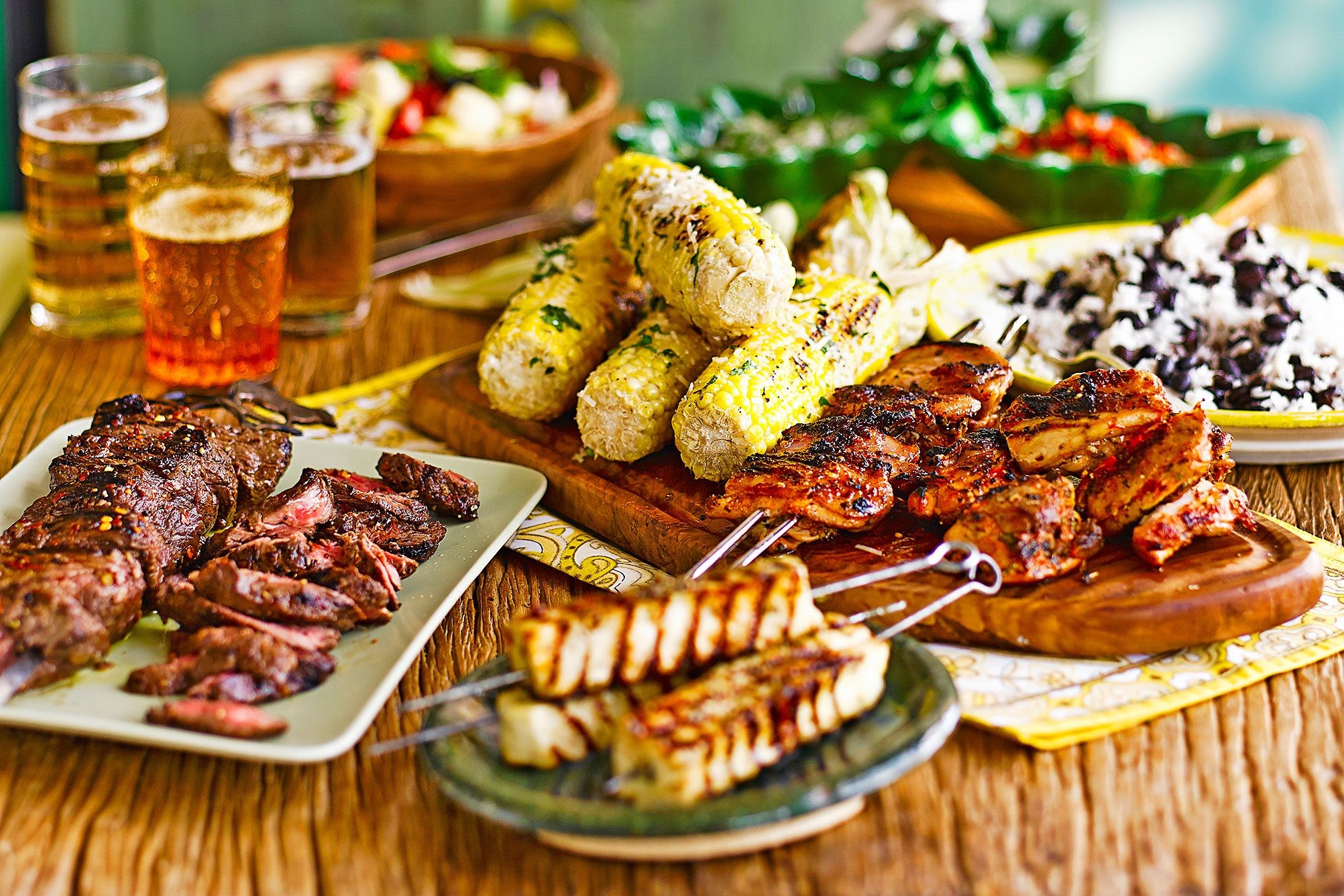Brazilian cuisine is a vibrant tapestry of flavors, influenced by indigenous ingredients, European colonization, and African heritage. This diverse culinary landscape offers a wealth of dishes that are both comforting and exciting. From succulent barbecued meats to flavorful seafood stews and irresistible sweet treats, Brazilian Foods are a true reflection of the country’s rich culture and history. If you’re looking to explore the tastes of Brazil, here are 10 essential Brazilian foods you absolutely must try.
1. Churrasco: The Art of Brazilian Barbecue
Brazil proudly shares the barbecue crown of South America with Argentina, but Brazilian churrasco boasts its own distinct style. It’s not just about grilling meat; it’s a social event, a celebration of flavor, and a testament to the quality of Brazilian beef. While both countries are passionate about barbecue, Brazil distinguishes itself through its cuts, seasonings, and the overall churrasco experience.
The star of the show is often picanha, the rump cap, a prime cut of beef simply seasoned with coarse salt to enhance its natural flavor. The meat is grilled over charcoal or wood, achieving a perfectly pink center and a smoky crust. Beyond picanha, a traditional Brazilian barbecue, or churrasco, features a variety of meats. Home gatherings often include sausages, queijo coalho – a unique squeaky cheese grilled on a stick – and even chicken hearts. For a truly immersive experience, visit a churrascaria, a Brazilian barbecue steakhouse. Here, passadores (meat waiters) circulate with skewers laden with an astonishing array of meats, from pork and lamb to wild boar and various cuts of beef, slicing portions directly onto your plate. The sheer quantity and variety are part of the churrasco charm – best enjoyed slowly and with plenty of space in your stomach!
Want to try making Brazilian barbecue at home? Here are some recipe ideas:
- Frango churrasco (grilled lemon & garlic chicken)
- Cumin & onion marinated beef
- Oregano cheese skewers
- Creamy Aji green sauce
- Chimichurri sauce
2. Moqueca: Aromatic Brazilian Fish Stew
Moqueca is more than just a fish stew; it’s a sensorial experience. Served in a traditional clay pot, the dish is unveiled at the table with dramatic flair, releasing fragrant steam that hints at the flavors within. The origins of moqueca are hotly debated between Bahia and Espírito Santo, two northeastern states of Brazil, with both Baianos (Bahia residents) and Capixabas (Espírito Santo residents) claiming to have invented this iconic dish. Each region offers its own delicious variation.
At its core, moqueca is a seafood stew featuring fish and/or other seafood simmered in a base of diced tomatoes, onions, and fresh coriander. The Capixaba version is known for its vibrant red color, achieved by the addition of annatto seeds, a natural food coloring. Bahian moqueca is richer and more intense, incorporating palm oil, bell peppers, and creamy coconut milk. Regardless of the regional variation, moqueca is typically served with rice, farofa (toasted cassava flour, perfect for soaking up the flavorful broth), and pirão (a thick, savory porridge made from cassava flour and fish broth – surprisingly delicious!). Moqueca is a true taste of Brazil’s coastal cuisine, embodying the freshness of seafood and the warmth of Brazilian spices.
Ready to experience the flavors of Moqueca? Try this recipe:
3. Cachaça: The Spirit of Brazil
Cachaça, Brazil’s national spirit, has a history dating back to the 16th century. Made from fermented sugarcane juice, it’s the essential ingredient in the caipirinha, Brazil’s iconic cocktail. While caipirinhas are often made with unaged, clear cachaça, the world of cachaça is far more nuanced. Thousands of high-quality, golden varieties exist, aged in wooden barrels, developing complex flavors that are savored neat by connoisseurs. Exploring the different types of cachaça is a journey into Brazilian craftsmanship and tradition.
Beyond cocktails, cachaça is deeply ingrained in Brazilian culture. And after indulging in the rich flavors of Brazilian food and perhaps a few caipirinhas, Brazilians have their favorite remedies. For a refreshing morning-after pick-me-up, try Guaraná Antarctica, a uniquely Brazilian sweet and fizzy soft drink; água de coco (coconut water), best enjoyed straight from a fresh coconut; or caldo de cana (freshly pressed sugarcane juice), a naturally sweet and energizing drink.
Mix up your own Brazilian cocktails with cachaça:
4. Brigadeiros: Brazil’s Irresistible Chocolate Truffles
Brigadeiros are Brazil’s delightful answer to the chocolate truffle, and they are ubiquitous at celebrations, especially children’s parties. Their simplicity is part of their charm, making them a beloved treat across the country. These sweet, fudgy balls are made by simmering condensed milk with cocoa powder and butter until thick and luscious. The mixture is then shaped into small balls and traditionally rolled in chocolate sprinkles, though variations with nuts or coconut are also popular.
Brigadeiros deliver an instant sugar rush and are undeniably sweet, which might be intense for some palates. However, for Brazilians, they are a nostalgic and cherished sweet, representing comfort and celebration. No Brazilian dessert spread is complete without a plate of these addictive little treats.
Indulge in the sweetness of Brazil and make your own brigadeiros:
5. Pão de Queijo: Cheesy Brazilian Bread
Pão de queijo, or Brazilian cheese bread, is a perfect example of how simple ingredients can create something truly special. Combining cheese and bread, two global comfort food staples, Brazil has created a moreish snack enjoyed throughout the day. These small, gluten-free rolls are crispy on the outside, with a soft, chewy, and cheesy interior. The magic ingredient is tapioca flour, which gives them their unique texture, combined with eggs and grated curado minas cheese, a cow’s milk cheese from the Minas Gerais state.
While traditionally small rolls, keep an eye out for larger versions of pão de queijo. Sometimes they come in fist-sized rolls or even cake-sized bakes, often stuffed with cream cheese or savory meat fillings for an even more indulgent treat. Pão de queijo is the perfect representation of Brazilian comfort food – simple, satisfying, and utterly delicious.
Experience the cheesy goodness of Pão de Queijo with this recipe:
6. Acarajé: Afro-Brazilian Street Food Delight
Acarajé is a quintessential Brazilian street food, particularly popular in Bahia, and a testament to the strong African influences in Brazilian cuisine. This calorie-rich snack is a deep-fried patty made from crushed black-eyed peas, palm oil, and pureed onions. The mixture is deep-fried again in palm oil until golden brown and crispy. The acarajé is then sliced open and stuffed with dried shrimp and vatapá, a rich and spicy puree of prawns, bread, cashew nuts, and other flavorful ingredients.
Originating from Bahia in northeastern Brazil, acarajé’s flavors are deeply rooted in West African cooking traditions. The best way to enjoy acarajé is piping hot, fresh from the fryer, generously drizzled with a fiery chilli sauce. It’s a flavorful explosion that embodies the vibrant street food culture of Brazil.
Try making your own Acarajé and experience these unique flavors:
7. Quindim: Sweet and Silky Egg Yolk Dessert
Quindim, another culinary gem from Bahia, is a visually stunning and intensely flavored sweet treat. Its glossy yellow color and unique texture make it instantly recognizable. Made with just eggs, sugar, and coconut (butter is often added for richness), quindim is baked in individual cupcake-sized molds. The base becomes toasted and golden brown, dense with grated coconut, while the top transforms into a smooth, firm custard that melts in your mouth.
The name quindim is believed to come from ‘kintiti’, meaning ‘delicacy’ in Kikongo, a Bantu language spoken in parts of Africa, reflecting the African influences on Bahian cuisine. The recipe itself draws inspiration from Portuguese confectionery traditions, known for their love of egg yolks in sweets and pastries. Quindim is a perfect example of the fusion of flavors and techniques that defines Brazilian desserts.
Indulge in the silky sweetness of Quindim with this recipe:
8. Açaí: The Amazonian Superfood
Açaí, a fruit from the Amazon rainforest, has gained global recognition as a superfood, and for good reason. Traditionally consumed by indigenous Amazonian tribes for its energy-boosting properties, the small, dark purple berry is also used in savory Amazonian cooking as a sauce for fish. However, it was a clever marketing campaign in the 1980s that propelled açaí into mainstream popularity in Brazil, particularly among surfers in Rio de Janeiro, as a healthy energy snack.
Today, açaí is enjoyed throughout Brazil, most commonly as a sweet, thick, frozen sorbet. Often served in bowls topped with granola and banana slices, or blended into refreshing juices, you can find açaí in virtually every café, bakery, juice bar, and supermarket across the country. The versatility of açaí extends even further – you can even find açaí vodka and açaí beer, showcasing its widespread appeal and integration into Brazilian culinary culture.
Enjoy the refreshing and healthy taste of Açaí with this recipe:
9. Feijoada: Brazil’s National Stew
Feijoada is arguably Brazil’s national dish, a hearty and flavorful black bean stew enjoyed across the country. It’s a culinary melting pot, combining black beans with various cuts of pork and sausages. Traditionally, less-prized cuts of pork, such as trotters and ears, are included for depth of flavor, though modern versions may use more conventional cuts. Feijoada is a labor of love, especially when made in the traditional way, which can take up to 24 hours, including soaking the beans and desalting the pork.
Due to its complexity and preparation time, most Brazilians prefer to enjoy feijoada at restaurants and bars, where it’s often served as a weekend specialty, particularly on Wednesdays and Saturdays. Feijoada is typically accompanied by rice, sautéed kale, orange slices (to aid digestion), farofa (toasted cassava flour), and crispy pork scratchings. A shot of cachaça is also often served alongside to further aid digestion after this rich and satisfying meal.
Experience the comforting flavors of Feijoada with these recipes:
- Feijoada (black bean and meat stew)
- Brazilian pork stew with corn dumplings (a Feijoada-inspired dish)
10. Fried Bar Snacks: Perfect Brazilian Appetizers
In Brazil, ice-cold beer is the beverage of choice, and what better to pair with a cold beer than a selection of delicious fried bar snacks? Brazilian bars and botecos (informal bars) offer a tempting array of fried appetizers, perfect for sharing and enjoying with friends. Pastéis, crispy deep-fried pastries filled with melting cheese, minced beef, or creamy hearts of palm, are a classic choice. Crunchy batons of manioc (cassava) and bolinhos (‘little balls’), often made with salt cod (bacalhau), are also popular.
Coxinha, meaning ‘little thigh’, is another beloved fried snack. Made with shredded chicken and mashed potato, shaped to resemble a plump chicken thigh, and coated in golden breadcrumbs, coxinhas are a satisfying and flavorful bite. These fried snacks are the perfect introduction to Brazilian flavors and the ideal accompaniment to a relaxed evening with drinks.
Bring the Brazilian bar snack experience home with these recipes:
Explore More Culinary Delights:
- Top foods to try in Goa
- Top foods to try in Kerala
- Top foods to try in Croatia
- Top foods to try in the Ionian islands
- Top foods to try in Provence-Côte d’Azur
- Top foods to try in Ireland
Are you a lover of Brazilian cuisine? What are your favorite Brazilian foods? Share your must-try dishes in the comments below!
Catherine Balston is a food & travel writer based in São Paulo.


